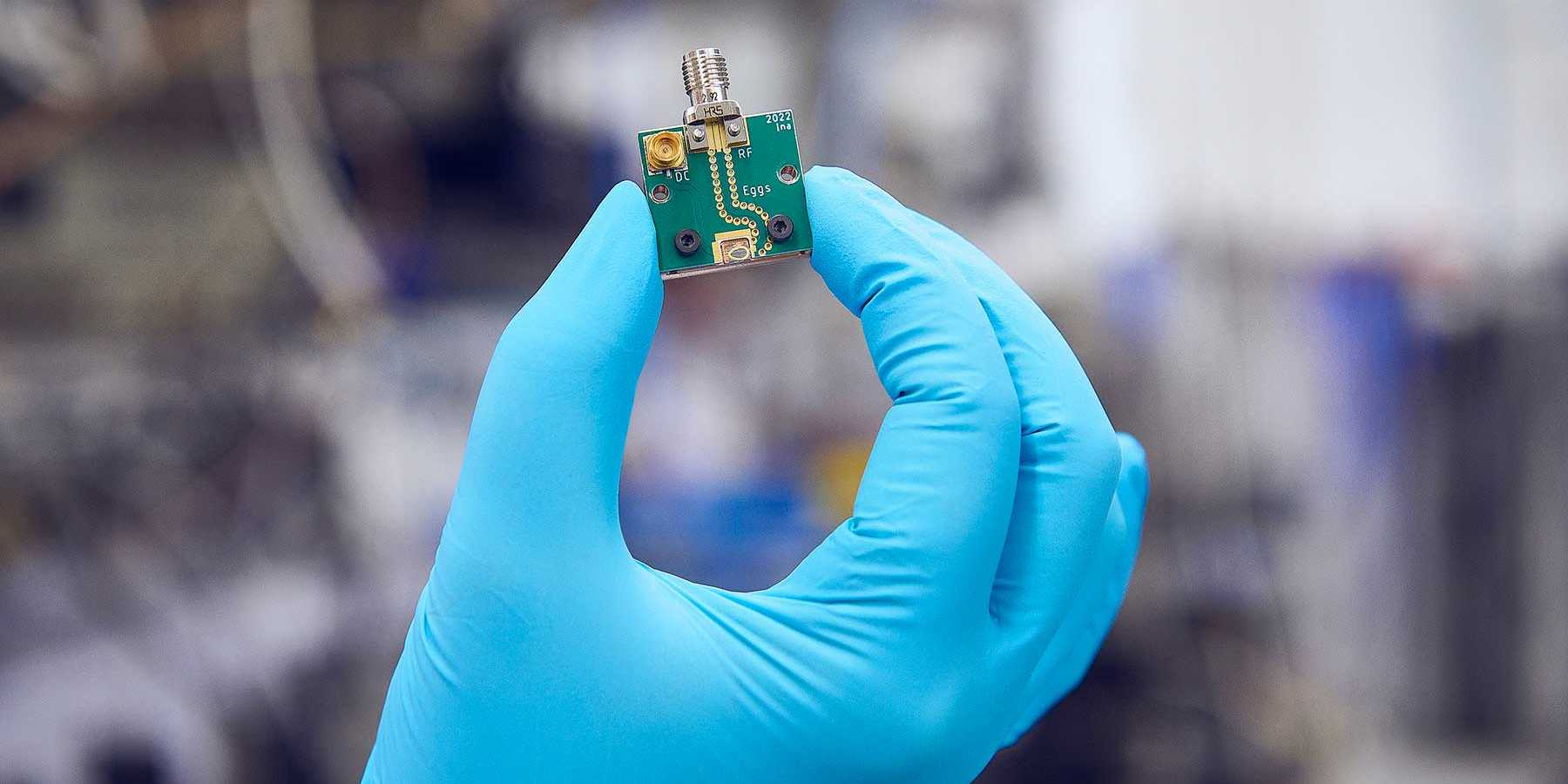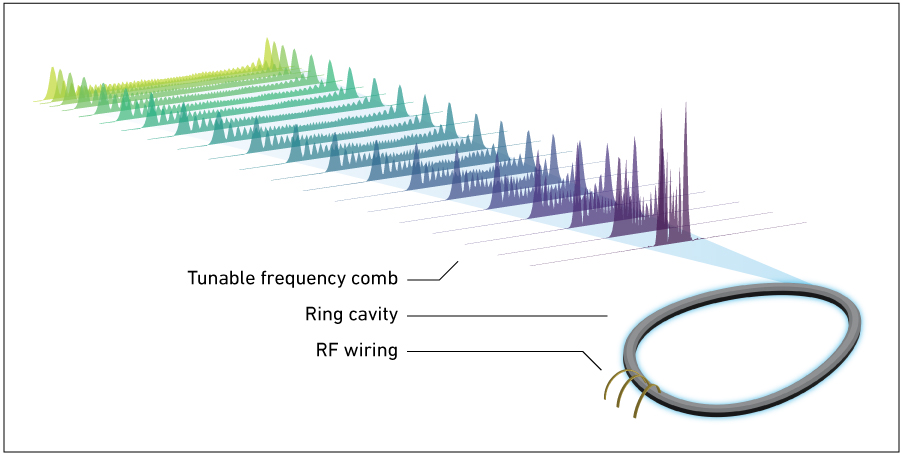The walk that leads to the comb
Using a random walk generated by modulating a ring quantum cascade laser, researchers from the Institute for Quantum Electronics at ETH Zurich have realised a new type of frequency comb.

Physicists like to use vivid images to describe complex processes. An example is the so-called random walk, which describes what happens to a walker whose wandering is determined by random choices of walking direction at each fork along his or her path. Such a random walk can be used, for example, to model the Brownian motion of molecules in a classical gas. When random walks are applied in quantum physics, additional physical phenomena arise that stem from the wave-like nature of the particles and the associated superposition and interference effects.
Ina Heckelmann and colleagues from the group of Jérôme Faist and Giacomo Scalari in the Institute for Quantum Electronics used a quantum-mechanical random walk to create a new type of frequency comb in the mid-infrared range, which is extremely stable and at the same time has a broad and adjustable frequency spectrum. Their results have just been published in the journal Science.
Fast modulation of the laser gain
Frequency combs are laser beams with a frequency spectrum consisting of regularly spaced, narrow frequency lines. Such combs can be generated in various ways, for example with a mode-locked laser that outputs regular short laser pulses or by a four-wave-mixing process in a nonlinear medium. Heckelmann and collaborators have now found another strategy, which Slovenian-American physicist and engineer Hermann A. Haus had already described theoretically in the mid-1970s: active mode coupling through fast modulation of the cavity losses or round-trip phase. At that time, however, available gain media limited the output of such lasers to combs with narrow pulsed spectra.
In the nineties, Jérôme Faist and Federico Capasso invented the quantum cascade laser (QCL), in which electrons emit light as they move between quantum wells in a semiconductor material made up of thin layers. By applying an external electric field, the gain of this active medium can be changed – and this change is fast, as it takes place within hundreds of femtoseconds. This feature makes it possible to design a ring-shaped quantum cascade laser (also known as ring QCL) where the gain is modulated synchronously with the light circulating in the ring, that is, where one modulation period corresponds to one round-trip of the laser light.
Building a ring QCL involves the fabrication of a ring-shaped waveguide made up of the active gain medium (composed of InGaAs/InAlAs layers) on a semiconductor chip. When Faist and his coworkers injected into the active region an oscillating voltage with a period that matches the round-trip time of the infrared light in the laser cavity, they found out that the light emitted by this ring laser has a very broad frequency spectrum with regularly spaced frequency lines – in other words, they produced a broadband frequency comb.

Random walk in frequency space
The work of Heckelmann and colleagues now clarifies, through experimental characterisation and mathematical modelling, what happens inside the ring QCL and how the comb forms: light performs a random walk owing to the periodic external modulation of the laser gain and round-trip phase in the active region. The walk doesn't take place in the three spatial dimensions, however, but in frequency – or synthetic – space. At every round-trip, the fast gain modulation enables a coupling between the comb frequency lines through interference in the ring laser: each time the laser light (that is, the walker) can 'decide' whether to move to the higher or to the lower neighbouring frequency. As the process is coherent, the resulting quantum-mechanical random walk leads to a broad and uniform distribution of light intensity at different frequencies. By contrast, in the case of a typical slow gain medium one would expect a narrower, Gaussian distribution of intensity.
Egg-improved light extraction
For the resulting frequency comb to be practically useful, the team had to find a way to collect the laser light from one preferential direction out of the ring cavity. Indeed, ring lasers usually emit light isotropically. By using an egg-shaped waveguide instead of a perfectly round one, Heckelmann and colleagues were able to maximise the light extraction efficiency of the laser at one specific exit point on the ring without affecting the other properties of the ring QCL. In practice, they optimised the geometry of the cavity thanks to Hügelschäffer's egg model, a mathematical formula that uses three parameters to describe differently shaped eggs. The egg shape ensures that the local radii of curvature of the waveguide are distributed so that especially high output radiation can only be expected at a single point.
The team identifies a first potential application for their random walk frequency comb in trace gas analysis, which can be used to detect spectroscopic fingerprints of very weakly concentrated molecules in a gas. As the new frequency comb is extremely stable, metrological applications requiring reliable reference frequencies are another possibility. In the near future, the researchers would like to extend the wavelength range of this frequency comb into the near-infrared region, as this would make it possible to couple the laser light into fibre-optic cables and thus help to bring telecommunication applications within closer reach. With its modulation-adjusted comb width, the random walk frequency comb could also be useful for miniaturised, on-chip spectroscopic applications that do not rely on adjustable mirrors.
Translated from German by Gaia Donati
Reference
Heckelmann, I. et al. Quantum walk comb in a fast gain laser. Science 382, 434-438 (2023). external page DOI:10.1126/science.adj3858
Further reading
Haus, H.A. A theory of forced mode locking. IEEE Journal of Quantum Electronics 11, 323-330 (1975). external page DOI:10.1109/JQE.1975.1068636
Faist, J. et al. Quantum cascade laser. Science 264, 553-556 (1994). external page DOI:10.1126/science.264.5158.553